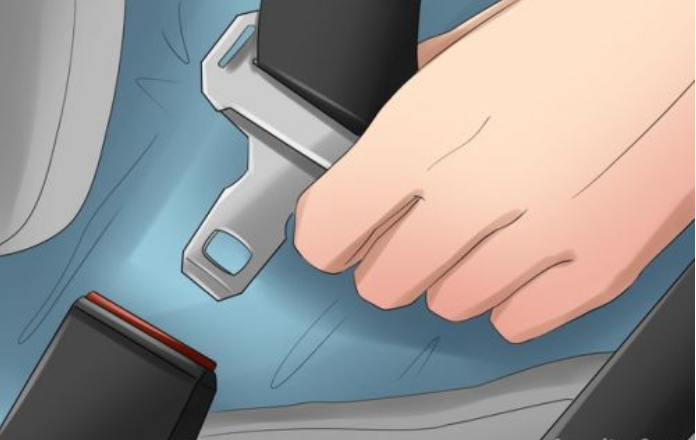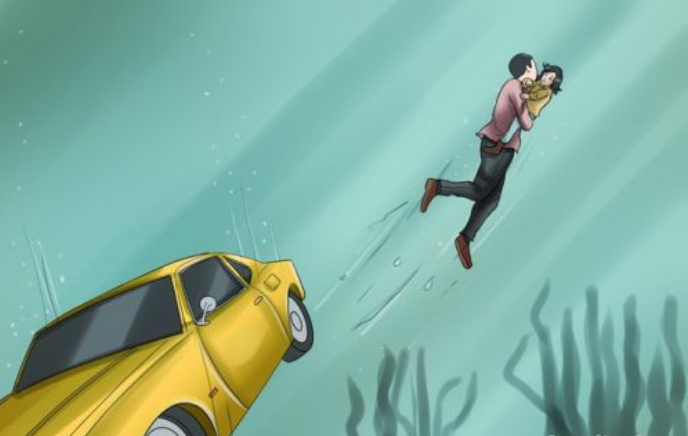Imagine this terrifying scenario: you’re driving along, and suddenly, your car plunges into water. It’s a situation most people never anticipate, but it’s more common than you might think—especially during heavy rains, floods, or accidents near bodies of water. The good news? You’ve got between 30 to 120 seconds to act before the car begins to sink. This brief window of time is your “golden opportunity” to escape. Knowing exactly what to do during these critical moments can save your life and the lives of your passengers. Here’s how to effectively escape from a sinking car.
Why Time Is Your Biggest Enemy in a Sinking Car
When a car enters the water, it doesn’t immediately sink. It typically floats for about 30 to 120 seconds, providing you with a small window to act. However, as water rapidly fills the cabin, the pressure builds, making escape increasingly difficult. Panic can also be your worst enemy in these moments, wasting valuable time. Staying calm and following a step-by-step approach can dramatically improve your chances of survival.
Step 1: Unbuckle Your Seatbelt Immediately

Your first action should be to unbuckle your seatbelt. It may seem obvious, but in high-stress situations, people often forget this critical step. Make it a habit to release your seatbelt as soon as you realize the car is in water.
Pro Tip: Practice quickly unbuckling your seatbelt in a parked car. Familiarity with this action can help you react faster under pressure.
Unbuckling your seatbelt allows you to move freely and prevents it from becoming a potential trap as the water level rises. If you have passengers, particularly children, assist them with their seatbelts next, prioritizing their safety.
Step 2: Use the Windows as Your Emergency Exit
Once everyone’s seatbelt is unfastened, shift your focus to the windows. They are your best exit option, as opening the doors becomes nearly impossible once the water pressure outside equalizes with the pressure inside. Trying to open the door too early can also accelerate the sinking process by allowing water to rush in faster.
Here’s What to Do:
- If power windows are working, roll them down immediately to create an exit. Car electrical systems often remain functional for a few minutes after hitting the water.
- If the windows won’t open, use a window-breaking tool (ideally kept in the glove box or center console) to break a side window. Aim for the corners, as the center is typically reinforced.
- If you don’t have a window-breaking tool, use any hard, pointed object within reach, such as a headrest, keys, or even a shoe heel. Side windows are easier to break than the windshield or rear window.
Step 3: Exit the Car Quickly
Once a window is open or broken, it’s time to exit. Your top priority should be getting children or weaker passengers out first. Guide them to take a deep breath and hold onto you or a floating object as they exit.
Important Tips for Exiting:
- Push children out through the window first, as it’s easier to help them exit before you do.
- If you’re alone, brace yourself, take a deep breath, and push out through the window.
- Swim toward the surface, following the direction of light or air bubbles, which can guide you upwards.
Step 4: What to Do If the Car Is Fully Submerged

If you’re unable to exit before the car becomes fully submerged, don’t panic. The pressure inside and outside will eventually equalize, making it possible to open the door—although you might have to wait for the cabin to fill with water up to chest level.
Follow These Steps:
- Take a deep breath as the water rises to your chin.
- Brace yourself and attempt to open the door once the pressure equalizes, or use a window-breaking tool if it’s still accessible.
- Exit through the window or door as quickly as possible and swim to the surface.
Step 5: Stay Calm and Don’t Waste Time

Panic is a natural reaction in life-threatening situations, but it can also be deadly. You need to stay focused and act quickly. Experts emphasize that the first 30 seconds are the most critical for escaping the vehicle safely. Avoid calling for help immediately; use that time to get out of the car. Prioritize your actions: unbuckle, open or break the window, and exit.
How to Help Passengers Escape Safely
If you’re not alone in the car, maintaining control of the situation is crucial. Your primary role is to keep everyone calm, explain what you’re doing, and help them follow your lead. Start with children, who are more vulnerable and likely to panic.
Steps to Help Others:
- After unbuckling your own seatbelt, assist others in releasing theirs.
- Guide children or passengers to the window, explaining how to hold their breath and exit.
- Push them out through the open or broken window, then follow them out.
- If necessary, carry a small child while swimming to the surface.
Why You Need a Car Escape Tool

A car escape tool is a simple, inexpensive device that can save lives in emergencies. These tools typically include a window-breaking hammer, a seatbelt cutter, and sometimes a flashlight—all essential tools for escaping from a sinking car. It’s a small investment that can make a significant difference.
Keep Your Escape Tool:
- In the glove box
- In the center console
- On your keychain
Ensure it’s easily accessible and that everyone who drives the car knows how to use it.
Prevention: Be Prepared for an Emergency
While you can’t always prevent a car from entering the water, you can be prepared. Here are some additional safety tips to keep in mind:
- Educate your family about what to do if the car falls into water, particularly children and the elderly.
- Practice using escape tools in a safe environment so that everyone is familiar with how they work.
- Avoid risky driving conditions near water during floods or heavy rains whenever possible.
Conclusion: Knowledge Saves Lives
Escaping from a sinking car may seem like a nightmare scenario, but knowing what to do can mean the difference between life and death. The key is to act quickly, stay calm, and focus on the steps outlined above. Remember, you have a limited amount of time to escape, so make every second count. Equip your car with a window-breaking tool, rehearse emergency actions, and always be prepared—because readiness is your best defense.


